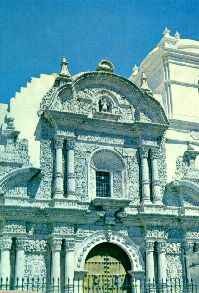|
Documentaries
Press
|
Rated 1.3/5
|

| Province: | Arequipa |
| Location: | about
a 1.000km from Lima, 2.230m above sea level |
| Population: | about
1 milion inhabitants |
| Weather: | all
year long sunny and dry, warm in the day and cold at night |
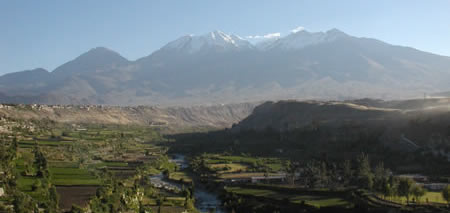
The Chanchani, one of three vulcanos visable around Arequipa
Inside
this page: |
|||||||||
| History | |||||||||
Buildings
in Arequipa
|
|||||||||
Around
Arequipa
|
|||||||||
(__to book your hotel go here__)
Arequipa
is located at an altitude of 2325 m in the desert mountains of the Andes. This beautiful
city is practically completly built out of sillar, a kind of white volcanic
stone. This is why Arequipa is called the White City. With its one milion
inhabitants, Arequipa is the second biggest city of Peru. The main square,
the Plaza de Armas is the most beautiful of the country. The magnificent
Catedrál and the shopping malls are in colonial style. It is the city of
eternal Spring. |
History
There are two theories about the origin of the name Arequipa. Long ago the Aymara Indians founded on this place a settlement. In their language, Aymara, "ARI" stands for "summit" and "QUIPA" for "laying behind". Indeed, the majestic volcano "el Misti" is seen from Arequipa. The second theory says that the name comes from the language of the Inca's, Quechua. The legend tells the story of Inca Mayta Capac, the fourth Inca, travelling through the valley. A column of militaries, sacred virgins and nobles escorted the Sapa Inca. Mayta Capac saw the settlement that was never before visited by any emperor. He was amazed by the beauty of this place and the strategic importance as a connection between the ocean and Cusco in the center of the Andes. He said: "Ari, quipay!" translated as "Yes, stay!" This was the answer on the desire of some of the fellow travelers the settle down on this place and to develop the area as an important city in the Inca empire. Arequipa was totally destructed in 1600 by a heavy earthquake and volcanic eruption.
The Spanish reestablished the city on the 15th of August 1540. This date is still remembered by festivities in and around Arequipa with carnivals and fairs in the evening during one week. The climax of the festival is on the 14th of August with a splendid firework on the Plaza de Armas.
El Misti (the Gentleman) is not the only volcano around Arequipa, but the most famous and elegant and in the middle of two smaller volcanoes, the "Chachani" (the Beloved) and the steep "Picchu Picchu" (the Top Top). The pressure between the tectonic plates of Latin America and the Pacific created some memorable dates in Arequipa. In 1687 and 1868 earthquakes destroyed almost every building in the city. Also the Catedrál and the San Francisco church were pretty damaged. The biggest part of these churches date beyond 1868. The renovation of the Catedrál finished in 1898. This is maybe why the church looks quiet cool inside in comparison with other cathedrals in Peru. The Catedrál looks impressive from the outside in the in Peruvian so beloved baroque style.
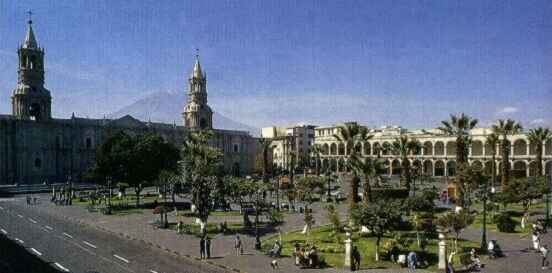
A church that peculiarly offered a lot of resistance against the earthquakes is "la Compañía". It is unknown when this building was established. Above the entrance hall we read 1698, but other parts of this Jesuit church date from 1654. Because of its odd style we recommend to visit this church. Don't forget to leave you footprints in the Ignacio-chapel as well. "La Compañía" is situated on the Plaza de Armas (see picture above, in the background is the Chachani volcano visible). Opening hours vary, but the best time to visit "la Compañía" in the morning or the afternoon.
By far the most interesting place to visit in Arequipa is the convent of Santa Catalina. It is built as a city in a city around 1580 and expanded in the 17th century. This is probably the biggest convent in the world. 450 nuns lived there for over 400 years, totally cut off the outside world. The inhabitants of Arequipa had no clue of what happened between the high walls of the complex. Lot's of fantasies and tales circulated under the people. Santa Catalina wrapped itself in mystery and silence until 1970 when a big part of the convent opened its doors for the public. There are still nuns living in the north area of the complex.
Enjoy your Peru family vacations with us, Peru is the perfect choice to bring your whole family and have a great time!
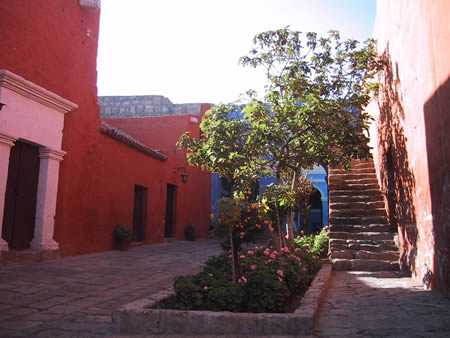
Locals and tourists with or without a guide can freely visit the remaining parts. Everything was beautifully renovated and the little streets and squares are full of colorful flowers and the walls are painted in fresh tints. Narrow alleys bring you to the different parts of the convent passing picturesque squares and odd living rooms with original furnishing. You can still smell the atmosphere of the dark Middle Ages visiting the dining hall, the square where nuns did their laundry, the washing hall and the extensive library with an incredible collection of books. Unfortunately the library is not always open to public.
Some visitors stay all day and melt away in the still living past of this convent or just wonder around and lose their way from time to time. Take your time to visit this wonderful place, it'll give you lots of inspiration. The convent of Santa Catalina is situated in the street with the same name and tree blocks away from the Plaza de Armas.
Colonial houses
Besides of religious buildings, Arequipa owns beautiful colonial houses form the 17th and the 18th century. Some of them are still private property; most of them are sold to banks or to reconstructed to shopping malls and hotels. Some of these fantastic colonial houses can still be visited. Pay special attention to the perfect workmanship, the gardens and the many statues and frontons.
Eternal snow is seen on the summits of "el Misti", the "Chachani" and the "Picchu Picchu". The coast is only two hours west and in the east you'll find the surrealistic volcanic area of Arequipa. In the national park of "Pampas de Cañihuas" graze lots of lamas and alpacas. The guanacos and vicuñas are also part of the scenery. So every visitor can see the four camel-like animals of Latin America in one day.
This endless plateau is situated at 3.800m and more. Views are spectacular. Passing a small mountain village Viscachani on 4.500m, the road continues climbing to an altiplano of 4.800m where little grows. The main vegetation are a very tough grass that grows 2 cm a year and a brown-like moss that grows peripherical. This is what the few animals adapted to these heights get to eat, the vicuña and the lama.
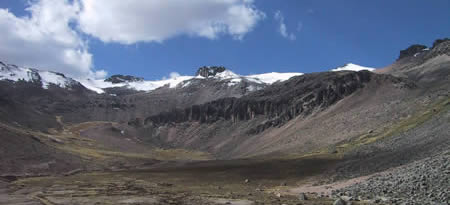
spectacular views in the national parks around Arequipa, to say the least
Passing this altiplano brings you into a valley where the road goes spectacular downhill to the mountain village Chivay. This place is the biggest town of the Colca Valley . Hotels and restaurants offer beds and food. Next to Chivay are the warm water springs of natural volcanic heated water. Approximately 600 years ago the Incas used this water to heal all kinds of skin diseases because of the green sulfur in the water. A simple but ingenious system of canals brings the water at a surface temperature 72°C to big swimming pools at 38°C. Swimming in this water is a relaxing and recommended experience while watching to huge mountains on the other side of the Colca River. So don't forget your swimsuit and towel on this trip.
 Chivay is
situated on 160km east of Arequipa and is the beloved resting-place to many tourists
going to the Colca Cañon. In the area
the people are proud to call this valley the deepest in the world: a mountain ridge
of 3.200m from summit to river. But this canon is visited by many to encounter the
biggest bird in the world: the condor. Although this species is
endangered by extermination, the occasion actually seeing a condor is reasonable.
These vulture-like birds hunt in the morning or late afternoon. Most condors are
between December and March at the coast because of the rain season in the Andes.
Chivay is
situated on 160km east of Arequipa and is the beloved resting-place to many tourists
going to the Colca Cañon. In the area
the people are proud to call this valley the deepest in the world: a mountain ridge
of 3.200m from summit to river. But this canon is visited by many to encounter the
biggest bird in the world: the condor. Although this species is
endangered by extermination, the occasion actually seeing a condor is reasonable.
These vulture-like birds hunt in the morning or late afternoon. Most condors are
between December and March at the coast because of the rain season in the Andes.
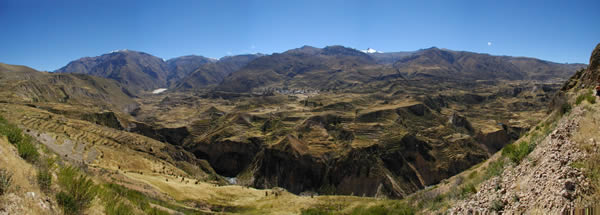
panoramic view of the Colca Cañon
On the way to the deepest place in the cañon, you'll see the mysterious Toro Muerto. This cemetery of the Wari Indians is built in a 90° steep cliff. It's hard to believe that these people brought their deaths to this place. It is even hard work for a professional climber to get there. The deaths were buried in the positions of a fetus, like all over Peru in ancient times. "Men has to leave the world as he came," said their unwritten bible.
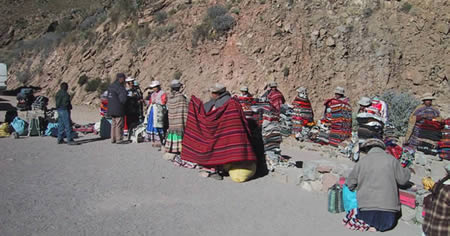
the market at the Cruz del Condor
Ten km farther up the road you get to the "Cruz del Condor" where the Colca River is seen 1.200m below. On the other side of the valley is Mont Mismi situated with its summit 3.200m above the Colca. Further downstream there are actually deeper canons but these are only accessible by foot and by trained hikers with a well packed backpack.
| Package Tours | Duration | Highlights |
| Arequipa City Tour | 2 hours and half
DAILY DEPARTURES from Arequipa |
Main tourist attractions of the city |
| Colca Canyon 2 Days | 2 Days and 1 Night
DAILY DEPARTURES from Arequipa |
Colca Canyon excursion |
| Colca Canyon 3 Days | 3 Days and 2 Nights
DAILY DEPARTURES from Arequipa |
Colca Canyon excursion |
| Climbing Chachani 2 Days | 2 Days and 1 Night |
climbing the Chachani (Altitude: 6,075 masl / 20,250 ft.) |
| Ascension To El Misti 2 Days | 2 Days and 1 Night
DAILY DEPARTURES from Arequipa |
Climbing El Misti (5,825 m / 19,222 ft.) |
| Arequipa Classic Tour 4 Days. | 4 Days and 3 Night |
Colca Canyon |
©2024 InfoPeru Best 1024 x 768 |
| Top | Cities | Machu Picchu | Inti Ramyi | Inca Trail | Incas | Email | Sitemap | About |
301742 visits
|
||||||||||||||||||||||||||||||||||||||||||||
